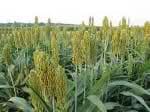“The livelihoods of billions of people in developing countries, particularly those in the tropics, will be severely challenged as crop yields decline due to shorter growing seasons.”
~ Robert Zeigler, IRRI director general~

Climate change threatens food crops across the world. And given the fact that most of the world’s food is grown in tropical countries where people are most vulnerable to climate change, predictions for future global food production could be far worst than earlier estimated. For a tropical country like the Philippines, these are the likely odds.
With the increasing frequency of climate change-associated natural disasters such as floods and droughts, researchers in the Philippines are re-focusing their R&D efforts to look for alternative crops that are not vulnerable to climate change. The trend now is to focus more on crop resilience rather than increasing the yield.
One crop that has been in the limelight for quite awhile since its introduction into the country in 2005 is sweet sorghum, dubbed as both a smart and a resilient crop.
As a smart crop
Sweet sorghum (Sorghum bicolor (L.) is a plant that grows to a height of 8 to 12 feet. It looks a lot like corn but with the grain on top rather than to the side.
Although not well known to most Filipinos, sorghum is the world’s fifth largest grain crop, next to rice, corn, wheat, and barley. It is grown in more than 42 million hectares (107 million acres) in 99 countries. Among the leading producers are the United States, Nigeria, India, China, and Mexico.
Essentially, sweet sorghum is being promoted as major source of bioethanol for addressing the energy problem in the country but it goes beyond that as it also provides human food, livestock feed and forage, and organic fertilizer. Hence, the 4Fs in sweet sorghum production: Fuel, Food, Feed/Forage, Fertilizer.
“We consider sweet sorghum an ideal ‘smart crop’ because it produces food as well as fuel. Sweet sorghum can help meet the country’s fuel needs without compromising our food supply,” said Dr. William D. Dar, director general of the India-based International Crops Research Institute for the Semi-Arid Tropics (ICRISAT), the international R&D center that brought the crop the Philippines.
Unlike other sources of feedstock for bioethanol, such as corn and sugarcane which compete with food supply and has a high water requirement to cultivate and grow, sweet sorghum is more productive on an annual basis and can withstand drought and has a better chance of surviving rains or storms.
Fuel. The main source of ethanol in sweet sorghum is the stalks which when crushed yields sweet juice that can be fermented and distilled to obtain bioethanol-a clean burning fuel with a high octane rating. With this technology at hand, the Philippines can go all out for the 10 percent bioethanol-blended gasoline to save an estimated 565 million liters of gasoline per year. This in turn will ease the country’s growing need for gasoline, a fossil-derived fuel, and lead to a great reduction in carbon emissions.
Food. The grain of sweet sorghum is a source of food. It is a promising cereal crop that could help address problems on malnutrition, dwindling food supply, and the increasing cost of wheat flour. Its grain is higher in protein and lower in fat than corn. It can be milled into flour as the main ingredient for soups and porridge, native delicacies, meals, and appetizers. The grains can be processed and used as an alternative to rice. Likewise, the sorghum kernel can be made into “pop sorghum”, a popular healthy snack.
Feed/Forage. A good source of energy and protein, the grain of sorghum can also be an important ingredient of feeds for poultry and cattle. Studies show that the feed value of sorghum grain is similar to corn. Although it is lower in vitamin A, sorghum grain has even more protein and fat than corn. When compared with corn on a per pound basis, sorghum’s feeding value ranges from 90% to nearly equal that for corn. The grain is highly palatable to livestock and its intake seldom limits livestock productivity. The grains have also been found to be an essential ingredient in the production of pre-conditioner feeds for fighting cocks.
The stripped leaves and crushed stalks of sweet sorghum are also good for large and small ruminants. The leaves and fibrous residue of sweet sorghum contain large quantities of protein, making it a valuable livestock feed. The fibrous residue can also be used as fuel for industrial boilers.
Fertilizer. Sweet sorghum bagasse produced from sweet sorghum can be converted into bio-organic fertilizer, which a cost-effective soil enhancer. Bagasse is the pulp or dry refuse left after the juice is extracted from sweet sorghum stalks in the process of production for sugar, ethanol production and other sweet sorghum products. Through the introduction of the microbial inoculant, Trichoderma harzianum, composting time is shortened from three months to just 3-4 weeks.
A 25,000 kg of sweet sorghum bagasse can produce 125 bags of the bio-organic fertilizer which can be sold at P230 per bag, with a gross value of P28, 750.
As a climate change-resilient crop
Aside from being a smart crop, sweet sorghum has also been dubbed as “the great climate crop’. Sweet sorghum is a resilient crop. It is easy to grow, and is resistant to pests and weed. It tolerates soil salinity, acidity and toxicity, and can withstand extremes of tropical weather, tolerating both heat and water logging.
Given its resiliency and adaptability to changing climates, sweet sorghum thrives even in marginal, arid lands which cannot be planted to rice, corn or sugarcane. Hence, sweet sorghum is a great solution to soil problems.
Planting sweet sorghum is cost effective too. It provides farmers profitable farming with its consistent cashflow and income in the long term. It provides better yield per hectare given its shorter crop cycle compared to crops such as sugarcane and cassava. The cost of growing sweet sorghum is four times lower than that of sugarcane, P 17,820 compared to P 44,250/ha/year according to ICRISAT.
Another positive climate change value of this crop is that it consumes less water. For one crop of 12 months, sugarcane uses 36,000 cubic meters of water per hectare; for two crops taking only 8-9 months, sweet sorghum consumes a mere 8,000 cubic meters which is comparatively 78 percent less water.
Public-private-farmer partnership
Upon its introduction into the country by ICRISAT, the Bureau of Agricultural Research (BAR) stepped forward as the first government agency to support the commercial production and utilization of sweet sorghum. With the Mariano Marcos Memorial State University (MMSU) at the helm of implementation in Northern Luzon, varietal adaptability trials were implemented in March 2006. More than a year later, the National Economic Development Authority (NEDA) supported the establishment of barangay-based technology demonstration on sweet sorghum.
Modeled after a public-private-farmer partnership, a development program on the wide production of sweet sorghum for ethanol, food, feeds, forage, fertilizer and other by-products was implemented. The program is anchored on the recent passing of the Philippine Biofuels Law (RA 9367 or Biofiels Act of 2006) and the goal of the Department of Agriculture (DA) of maximizing productivity in the marginal, underutilized/idle areas in the regions.
Given such a priority program, BAR further intensified its initiatives to focus on biofuels R&D to develop technologies that will sustain the production of the country’s domestic production of sweet sorghum as a viable source of energy.
Being the focal agency for biofuels in R&D, BAR’s goal is to consolidate current research and commercialization efforts on sweet sorghum, as well as provide relevant information on the adaptability of the crop and its multi-uses as food, feed and fuel (bioethanol). Accordingly, BAR has developed a framework for RDE on sweet sorghum and the plans for immediate and long-term activities for hastening sweet sorghum’s full utilization in the country.
The field tests of sweet sorghum at MMSU have shown encouraging results. Five out of the eight varieties of sweet sorghum bred by ICRISAT and brought into the country for field testing have been found to thrive well under Philippine conditions. These are NTJ 02, SPV 422, ICSV 93046, CSR 93034, and ICSV 700. They were found to have high content of juice and good grain yield when tested at the experimental farms of MMSU. Also, the crop has provided bright prospects, not only as feedstock for ethanol production, but also as food and feed grain.
Following the significant initial results of the studies, the five sweet sorghum varieties were then tried in 58 other sites across the country which similarly produced encouraging results as reported at the “First National Sweet Sorghum RD&E Review and Planning Conference” in March 2008.
The program was subsequently implemented in several areas in the Ilocos, Cagayan Valley, Cordilleras, Central Luzon, Bicol, and some provinces in the Visayas and Mindanao.
Given the successes of MMSU in Ilocos Norte, the Bicol Integrated Agricultural Research Center (BIARC) in Camarines Sur, these R&D Centers developed their respective region-wide commercialization of sweet sorghum with funding and coordinative support from BAR. This included the development of village-level technologies on food products and the production of molasses and organic fertilizer.
Replicating the “sweet” success
Now in its full scale of project implementation all over the country, BAR is moving for the commercialization of sweet sorghum given its proven potential as a source of bioethanol.
“Not to push out other important crops, such as corn and sugarcane which are also good sources of bio-ethanol, we must look at sweet sorghum not as competitor but as an opportunity given its potential, production- and yield-wise,” stressed Dr. Dar in a recent interview at BAR.
Dar further explained that an evolutionary approach in this trying time is that “while we continue the science of developing sweet sorghum for biofuel as a long-term plan, we must also look into intermediary approaches such as developing value-added food products from sweet sorghum.”
From the pilot areas in the Ilocandia, the program has spread to other regions in Cagayan Valley, Cordilleras, Central Luzon, and Bicol, some provinces in the Visayas and Mindanao, and recently to Mindoro, Cotabato and Bantayan Island.
According to Dr. Heraldo L. Layaoen of the Mariano Marcos State University (MMSU) in Batac, Ilocos Norte and who is the national program coordinator for the sweet sorghum project, the area planted for sweet sorghum in the country now totals to 310 hectares in piloting mode. MMSU piloted the field trials of sweet sorghum and currently has a stock of 288 varieties of sorghum, of which 19 varieties are said to be promising for ethanol production.
Dr. Dar has encouraged BAR to double if not triple the allocation for sweet sorghum. “It is important that BAR sustain its efforts on this crop and, as a long-term plan, establish an integrated Research Development and Extension (RDE) program on sweet sorghum,” said Dar.
In response, BAR has earmarked a P10-million budget for the implementation of sweet sorghum projects. Currently, BAR is coordinating and funding 17 projects all over the country. Twelve of these projects are implemented by the the Regional Integrated Agricultural Research Center (RIARCs) of DA. The rest are implemented by SUCs, specifically, the Central Luzon State University (CLSU), Pampanga Agricultural College, and Isabela State University (ISU) in addition to MMSU and the University of the Philippines Los Baños (UPLB) that conducted a feasibility study on sweet sorghum and cassava as viable feedstock for the production of biofuels.
Source: Rita T. dela Cruz – bar.gov.ph




Good day, Sir
Can you give us data for cost and return analysis for sorghum?
Thank you
Sir, where to buy seeds for sorghum rice?
Hallo i want to plant sweet sorghum in my plantation 100 ha. Where can I buy the seeds. Thank you
Hello! I want to plant sorghum in my 3 hectares land. Where can i buy sorghum seeds. Thank you.
Please i want to ask where to buy or order sorghum i am leaving here in cagayan de oro city
good morning sir.
i and my family on ilocos, norte used to plan this crop.
how can we be more productive using this crop?
can you please give us more option or more ideas how to make goods on it?
How can I start planting Sweet Sorghum?